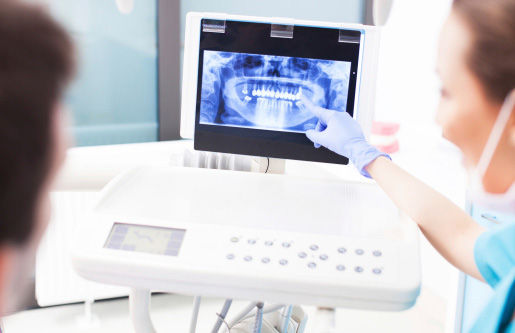Digital Radiography
Richmond, VA
 Digital radiography is essential in the diagnosis of oral-related problems and at Riverwind Dental, we believe that the better we understand something the better we can treat it. Dental radiographs are critical in diagnosing hidden cavities, early-stage periodontal disease, bone infection, and cysts. Digital radiography is essential in the diagnosis of oral-related problems and at Riverwind Dental, we believe that the better we understand something the better we can treat it. Dental radiographs are critical in diagnosing hidden cavities, early-stage periodontal disease, bone infection, and cysts.
Tooth decay is one of the most prevalent dental problems. Most people discover their tooth is decaying far late. But thanks to digital radiographs, our dental specialists can have a closer look at the hidden parts of your teeth and determine whether you have tooth decay and what kind of periodontal maintenance you need.
Digital radiography is a painless process that involves non-invasive light energy passing through the soft tissues of your mouth to reveal the internal structure of your oral cavity.
The Procedure of Digital Radiography
Digital radiography is an upgrade from dental x-rays. With the x-rays, a certain amount of radiation is emitted, which makes the procedure unsafe for certain patients. But digital radiography doesn’t emit any harmful radiation.
Digital radiography enables the display of your inner oral structure. A sensor is typically placed in your mouth, and there’s a wire attached to it running back to a computer, and the intricate images are relayed onto the computer.
Our dental professionals may manipulate these images to get a more accurate picture. The ability to capture the condition of your teeth at the smallest scale allows our dental specialists to diagnose various problems and provide treatment.
Digital radiography may be performed intra-orally or extra-orally. An intra-oral radiograph involves placing a sensor in the mouth, whereas an extra-oral radiograph doesn’t require anything to be put in the mouth. Yet, each method is great in different situations.
Digital radiographs don’t emit any harmful radiation, and thus they can be performed even on children and senior citizens. Taking regular digital radiographs is a proactive measure of avoiding various dental health problems.
Benefits of Digital Radiography
Digital radiography allows for the detection of several conditions of your teeth and jaws. The following are some of the benefits of this procedure.
Spotting Hidden Tooth Decay
Tooth decay is one of the most prevalent oral health issues. It affects the old and young alike. But most people hardly realize they have tooth decay until their tooth has suffered extensive damage. Digital radiography allows for the detection of hidden tooth decay.
Detecting Bone Loss in the Jaw
Different oral health problems can result in localized bone loss. And the loss of bone in your jaw makes you susceptible to conditions like temporomandibular joint disorders. Digital radiography allows for quick detection of bone loss in the jaw.
Teeth Positioning
Digital radiography is also critical in evaluating the alignment of your teeth before administering other treatments like dentures, implants, and braces. Our dental specialists manipulate the images to get an accurate look.
How Often Should My Teeth Be Radiographed?
The frequency of getting radiographed is dependent upon your dental history and current condition. If you have a preexisting dental disorder, you may be radiographed every six months, but someone who goes for regular dental checkups and whose teeth are in great condition might be radiographed every couple of years. Generally, children are radiographed a lot more than adults, because their teeth are still developing.
Digital radiography is critical for the careful examination of your teeth. Contact Riverwind Dental at (804) 280-0853 today to schedule an appointment.
|